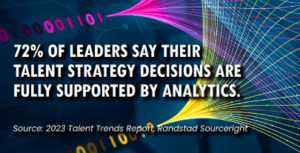Today’s sophisticated analytics can take recruitment programmes to the next level.
By Simon Kent
In recent years, data has been heralded as a valuable asset for HR, providing evidence of the function’s impact on the business. Measures concerning the availability of talent, the cost of recruitment, the cost of turnover, and more have helped to define the contributions HR can make as well as indicate improvements in processes. Data has also been tipped as being able to predict the future HR needs to deal with. Patterns and analytics can anticipate what is coming, but is HR actually making the most of this?
Jacinta Allerston, director of talent services at Sevenstep, says predictive algorithms can now identify or confirm the most suitable candidates at the sourcing and screening stages, enabling more refined approaches to assessment and interviews. The combination of this alongside market insights can produce more effective and appropriate sourcing strategies. It is certainly something which businesses are engaging in, where scale permits.
“Larger organisations have been faster to adopt predictive analytics because of more extensive resources,” she says, “and it could be argued, there’s more reliable comparative external market data versus smaller companies in niche industries whose exact hiring needs are often not reflected in macro market trends.”
That said, Allerston believes there is a place for predictive analytics for all hiring types, whether for highly competitive tech talent or high volume unskilled labour. “Predictive analytics can be used to gain a competitive edge, but also identify opportunities for leaner processes, removing bottlenecks, training needs or similar opportunities,” she explains.
Allerston also says that smaller organisations can use third-party partnerships—such as those through the right RPO partners—to access and utilise broader sources of data. In the process, they can gain some of the same advantages that larger companies have when it comes to predictive intelligence. “We see clients of all sizes benefit greatly from the access we provide to predictive intelligence,” she says.
“At Aaron Wallis, we use data extensively to inform our clients and improve our recruitment process,” says Rob Scott, managing director of the sales recruitment agency. The company collects data from various sources, including their CRM system, LinkedIn, and surveys. This provides tangible information including salaries in specific geographic areas and the availability of talent which in turn informs the work of Aaron Wallis and can shape expectations.
“We can also use this data to identify our consultants’ training needs and track the performance of our recruitment process,” says Scott. Metrics, including the number of candidates each consultant sources, the number of interviews conducted, how many of these convert to interviews, second interviews, and placements can all give useful feedback to consultants and identify training needs.
Scott says data is also used to inform the recruitment processes at work within the business. “We track metrics such as the time it takes to fill a role, the cost per hire, and the success of the candidates we place,” he explains. “This data ensures that we commit to continuous improvement and gain clarity on the areas that may require more attention.
“By using data in these ways, we can provide our clients with better service and improve the efficiency of our internal recruitment processes.”
Ben Keighley, founder of social media recruitment specialist Socially Recruited says his business uses more than two million data points, including skills-based targeting, and leverages AI to take candidates from being unaware of a role through to considering an application and ultimately to landing the job. This reduces the hiring time dramatically, as well as the cost per hire, while helping to plug the skills gap.
“It’s impossible to look at the future of recruitment and the use of data without looking at how AI will develop in the next few years,” he says. “While the first wave of AI was about classification, training a computer to classify data types such as images and language, we’ve now progressed to the generative wave, where AI takes that input data and produces new data.”
Keighley says the next stage will be the interactive phase where users can simply talk to their AI, give it a high-level goal, and see it take action. “This will have a profound impact on the world of recruitment, with AI being able to talk to people – and other AI tools – in order to identify a talent pool faster than ever before, cutting both costs and admin and improving the experience of candidates,” he says.
Marketing agency Pearl Lemon lists a number of areas where data is aiding and abetting their people processes. Data offers insights into talent pools, the candidate experience, and collaborative approaches with partners. Ultimately, argues Head of HR Taryn Kim Froneman, this leads to HR being able to offer more to the business.
“Our proactive recruitment strategies, fuelled by data, enable us to redefine success beyond traditional KPIs,” she says. “We’re no longer solely focused on filling roles; instead, we’re contributing to the organisation’s long-term growth by identifying emerging talent trends and aligning our strategies with these insights.”
As Sevenstep’s Allerston notes, data is not (yet) a certain or a stationary science, but one which must adapt according to circumstances and objectives. Data models need to be continually updated and evolved to be fit for purpose while the compliance issues around information use continue to change and evolve. “As tools are built with the appropriate perspectives considered, and data quality is continually validated with a robust audit process,” she says, “the data can then be reliably utilised to measure the performance of decisions taken.”

















